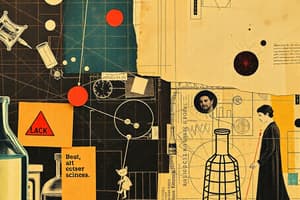Podcast
Questions and Answers
What is an isotope?
What is an isotope?
Atoms of the same element with the same number of protons, but different number of neutrons.
What does the number next to the isotopes signify? (i.e. Cr-52)
What does the number next to the isotopes signify? (i.e. Cr-52)
The atomic mass of the isotope.
How can you tell isotopes apart?
How can you tell isotopes apart?
By their neutrons and atomic mass.
How do isotopes compare in terms of atomic number?
How do isotopes compare in terms of atomic number?
What is the atomic mass?
What is the atomic mass?
What happens to the number of electrons in neutral isotopes?
What happens to the number of electrons in neutral isotopes?
What are the properties of isotopes?
What are the properties of isotopes?
What is abundance?
What is abundance?
What is the average atomic mass?
What is the average atomic mass?
How can you tell which isotope is more abundant?
How can you tell which isotope is more abundant?
Flashcards
What is an isotope?
What is an isotope?
Atoms of the same element with the same number of protons, but a different number of neutrons.
Isotope Number Meaning
Isotope Number Meaning
The number next to the isotope signifies the atomic mass of the isotope.
Distinguishing Isotopes
Distinguishing Isotopes
Isotopes are distinguished by their number of neutrons and atomic mass.
Isotopes & Atomic Number
Isotopes & Atomic Number
Signup and view all the flashcards
Isotope Atomic Mass
Isotope Atomic Mass
Signup and view all the flashcards
Isotopes & Electrons
Isotopes & Electrons
Signup and view all the flashcards
Isotope Properties
Isotope Properties
Signup and view all the flashcards
Isotope Abundance
Isotope Abundance
Signup and view all the flashcards
Average Atomic Mass
Average Atomic Mass
Signup and view all the flashcards
Determining Abundance
Determining Abundance
Signup and view all the flashcards
Study Notes
Isotopes Overview
- Isotopes are atoms of the same element, sharing the same number of protons, but differing in the number of neutrons.
- The number next to an isotope, such as Cr-52, represents its atomic mass.
Identifying Isotopes
- Isotopes can be distinguished by their neutron count and atomic mass.
- They maintain the same atomic number, meaning they have an identical number of protons.
Atomic Mass Considerations
- Isotopes have varying atomic masses due to differing neutron counts, which contributes to the overall mass of the atom.
- In neutral isotopes, the number of electrons remains unchanged because the proton count is stable.
Properties and Abundance
- Physical properties of isotopes remain constant except for mass; however, chemical properties are identical due to similar electron arrangements in the outer shell.
- Abundance refers to the average quantity of a specific isotope found naturally on Earth.
Average Atomic Mass
- The average atomic mass listed on the periodic table is calculated based on the weighted average of all isotopes of an element.
- The isotope with the greatest abundance will skew the average atomic mass closer to its isotopic mass.
Studying That Suits You
Use AI to generate personalized quizzes and flashcards to suit your learning preferences.




